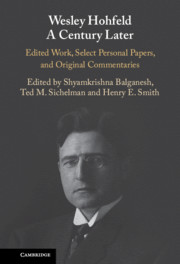Book contents
- Wesley Hohfeld A Century Later
- Wesley Hohfeld A Century Later
- Copyright page
- Contents
- Figures
- Tables
- Contributors
- Introduction: Hohfeld at the Crossroads
- Some Fundamental Legal Conceptions as Applied in Judicial Reasoning
- Selected Personal Papers of Wesley Newcomb Hohfeld
- Part I Philosophy of Jural Relations
- Part II Hohfeld and Property
- 5 Property’s Building Blocks: Hohfeld in Europe and Beyond
- 6 The In Rem/In Personam Distinction and Conceptual Partitioning for Persistence
- 7 Hohfeld and the Theory of In Rem Rights: An Attempted Mediation
- Part III Hohfeld and Equity
- Part IV Hohfeldian Complexities
- Part V Hohfeld and Society
- Index
6 - The In Rem/In Personam Distinction and Conceptual Partitioning for Persistence
from Part II - Hohfeld and Property
Published online by Cambridge University Press: 14 July 2022
- Wesley Hohfeld A Century Later
- Wesley Hohfeld A Century Later
- Copyright page
- Contents
- Figures
- Tables
- Contributors
- Introduction: Hohfeld at the Crossroads
- Some Fundamental Legal Conceptions as Applied in Judicial Reasoning
- Selected Personal Papers of Wesley Newcomb Hohfeld
- Part I Philosophy of Jural Relations
- Part II Hohfeld and Property
- 5 Property’s Building Blocks: Hohfeld in Europe and Beyond
- 6 The In Rem/In Personam Distinction and Conceptual Partitioning for Persistence
- 7 Hohfeld and the Theory of In Rem Rights: An Attempted Mediation
- Part III Hohfeld and Equity
- Part IV Hohfeldian Complexities
- Part V Hohfeld and Society
- Index
Summary
In the second of his two famous articles, Hohfeld seeks to do for the in rem/in personam distinction what he did so persuasively in his first for the terminology of rights, claims, duties, privileges, powers, immunities, and disabilities, which was to identify their essence, and to thereby describe the “natural kind” (in more modern parlance) lurking beneath the thicket of confused juristic rhetoric.1 The thesis in this second article, however, is a simpler and in some way more beguiling one than in his first. He claims that what the distinction between in rem and in personam jural relations comes down to is the contrast between what he calls “multital” and “paucital” relationships.2
- Type
- Chapter
- Information
- Wesley Hohfeld A Century LaterEdited Work, Select Personal Papers, and Original Commentaries, pp. 258 - 272Publisher: Cambridge University PressPrint publication year: 2022



